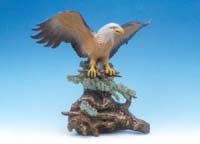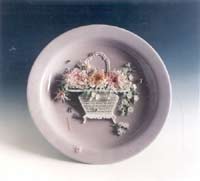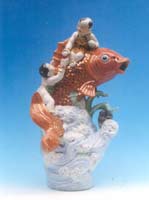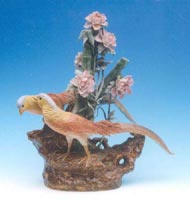|
Ceramic Culture and Folk-custom
 As a form of functional art and folk art, ceramics is closely related to the folk culture and widely reflects the social life and status of the people, and their aesthetic taste. In whatever circumstances in the various periods, the Chinese people insist on a good tradition of loving life and searching for happiness, harmony and auspiciousness, which results in their favor in the themes of happiness and blessings for thousands of years. As a form of functional art and folk art, ceramics is closely related to the folk culture and widely reflects the social life and status of the people, and their aesthetic taste. In whatever circumstances in the various periods, the Chinese people insist on a good tradition of loving life and searching for happiness, harmony and auspiciousness, which results in their favor in the themes of happiness and blessings for thousands of years.
The auspicious themes focus on "blessings, emolument, longevity, happiness, harmony, satisfaction, and their like", therefore the following objects are often chosen in ceramic art: such rare birds as phoenix-which, as the king of birds, symbolize wealth and nobility, and a couple of which embodies love, white crane-a metaphor of aloofness from material pursuits, purity and longevity, Chinese bulbul, magpie, mandarin duck and eagle; such rare flowers as peony which is the king of flowers and symbolizes wealth, nobility and prosperity, cotton rose hibiscus symbolizing grace and nobility, lotus, plum blossom and chrysanthemum; such sweet grass as orchid which is called the source of fragrance and has noble descendents, glossy ganoderma symbolizing longevity; such wood and bamboo as pine symbolizing longevity and moral integrity, bamboo, and heavenly bamboo which is pronounced as "Tian zhu"-heavenly blessings; such fruits as peaches that are called the longevity peaches, megranates, the numerous seeds of which symbolizing the happiness of having many descendents; such miraculous animals as dragons symbolizing kingship, authority and auspiciousness, lions "shi"- having the same pronunciation with "teacher" and "poetry", which symbolizes power and knowledge in keeping the prosperity of a family, deer "lu" having the same pronunciation with emolument "lu"; such fish as carps "li yu"-"li" is pronounced the same with rites "li", "yu" the same with wealth "yu", mandarin fish "gui" the same with nobility "gui". These themes of auspicious signs have further been developed into a whole system of symbolic patterns in a given history. Successively giving birth to lots of children is symbolized by an infant holding a lotus, having both happiness and longevity by a bat together with the character of "longevity shou", bamboo notifying the peace by children playing fireworks, luck and satisfaction by a child riding a white elephant with a "ru yi" in his hand, joy by a magpie in a plum blossom tree, happiness by a bat and a magpie, harmonious spring by a deer, a crane and plum blossoms, kylin sending a child to a family by a child riding kylin, well-being every year by lotus and fish, five children passing the imperial examinations by five children, blessing by immortals by immortals and bats, five happiness holding longevity by five bats encircling the character of longevity "shou", plenty of happiness and longevity by a throng of bats and a pile of peaches, happiness and longevity by an elderly riding a deer with a peach in his hand, the pockmarked girl offering longevity peaches by a pockmarked girl carrying a basket of peaches, winning promotion by the carps jumping beyond the dragon gate, the red phoenix towards the sun by a phoenix and the sun, and the dragon and the phoenix showing auspiciousness is symbolized by a dragon and a phoenix. having the same pronunciation with "teacher" and "poetry", which symbolizes power and knowledge in keeping the prosperity of a family, deer "lu" having the same pronunciation with emolument "lu"; such fish as carps "li yu"-"li" is pronounced the same with rites "li", "yu" the same with wealth "yu", mandarin fish "gui" the same with nobility "gui". These themes of auspicious signs have further been developed into a whole system of symbolic patterns in a given history. Successively giving birth to lots of children is symbolized by an infant holding a lotus, having both happiness and longevity by a bat together with the character of "longevity shou", bamboo notifying the peace by children playing fireworks, luck and satisfaction by a child riding a white elephant with a "ru yi" in his hand, joy by a magpie in a plum blossom tree, happiness by a bat and a magpie, harmonious spring by a deer, a crane and plum blossoms, kylin sending a child to a family by a child riding kylin, well-being every year by lotus and fish, five children passing the imperial examinations by five children, blessing by immortals by immortals and bats, five happiness holding longevity by five bats encircling the character of longevity "shou", plenty of happiness and longevity by a throng of bats and a pile of peaches, happiness and longevity by an elderly riding a deer with a peach in his hand, the pockmarked girl offering longevity peaches by a pockmarked girl carrying a basket of peaches, winning promotion by the carps jumping beyond the dragon gate, the red phoenix towards the sun by a phoenix and the sun, and the dragon and the phoenix showing auspiciousness is symbolized by a dragon and a phoenix.
 People began to be conscious of the auspicious signs in very ancient times. The design of phoenix appeared on the jade wares of the Shang dynasty. According to a legend, "the phoenix was singing in the mountain of the Western Zhou" when King Shangzhou was going to be replaced by King Zhouwen, in which the coming phoenix represented the virtuous worthy sovereignty was coming. People began to be conscious of the auspicious signs in very ancient times. The design of phoenix appeared on the jade wares of the Shang dynasty. According to a legend, "the phoenix was singing in the mountain of the Western Zhou" when King Shangzhou was going to be replaced by King Zhouwen, in which the coming phoenix represented the virtuous worthy sovereignty was coming.
In ancient China, the society is based on the hometowns constituted by kinship, therefore all the people long for bringing honor to their ancestors, the ever-lasting prosperity, wealth and nobility of their families, which are seen in the works of auspicious signs. The origin of the auspicious signs is closely related to the shamanism worshipped by the ancestral people. The auspicious birds and animals, clouds and "qi", and fish also reflect our love for and harmony with nature.
 The origin of the auspicious signs reflects the psychology, culture and philosophy of a nation. Confucianism, which advocates the consonance between man and nature, exerts the most important impact on the national culture and psychology of the Chinese people. The consonant relationship is expressed by giving the auspicious symbolism to the flowers, bird, worms, fish, animals, and so on. The origin of the auspicious signs reflects the psychology, culture and philosophy of a nation. Confucianism, which advocates the consonance between man and nature, exerts the most important impact on the national culture and psychology of the Chinese people. The consonant relationship is expressed by giving the auspicious symbolism to the flowers, bird, worms, fish, animals, and so on.
In addition, the auspicious birds, immortal Nezha fighting in the sea, the dragon boats, and the female star of longevity are oftentimes observed in the works from Jingdezhen, the capital of ceramics.
Therefore we need to understand the Chinese philosophy, religions, and psychology, and to be cultivated in the Chinese culture, music, dance, and so on, otherwise it would be too difficult for us to understand the aesthetic traits of the ceramic art works.
Ceramic Culture and Philosophy

|

